Kars Night Storm
prehistory
Kars was one of the main strongholds of the Turkish Empire in the Caucasus. Russian army in the XIX century. took the strongest fortress on the eastern frontiers of the Ottoman Empire Kars four times - in 1807, 1828, 1855 and 1877. In the Crimean (Eastern) War 1853-1856. Following the peace negotiations at the Paris Congress, Karsky fortress was exchanged for the sea fortress of Sevastopol. That was the price of Kars. It was a strategic fortress.
After each defeat in the Caucasus, Istanbul made three decisions to modernize the fortifications of the Kara Fort. Therefore, in 1877, the Russian Caucasian Army, approaching the Turkish stronghold, saw an improved fortress, fortifications of which were powerful forts and a citadel. The fortress was strengthened by nature itself - mountain heights with steep cliffs, rivers in rocky shores, high mountain passes and roads more reminiscent of goat trails. During the spring-summer campaign of 1877, the Russian army approached Kars. However, due to command errors and the general unfavorable situation, Russian troops retreated to the border.
A new phase of the battle for the Caucasus began in the fall of 1877. After the defeat in the Avlar-Aladzhinskom battle, the Turkish army of Mukhtar Pasha was demoralized (The brilliant victory of the Russian army in the Battle of Avliyar-Aladzhinskom). There was a real opportunity to take Kars on the run, with vigorous pursuit to finish off the Turkish army and then go out to Erzerum, who would have no one to defend. But the Russian command again showed indecision and excessive caution. The main forces of the acting corps were divided into two groups: the first under the command of General Lazarev was intended for the siege of Kars; second general Geiman - for movement on Erzurum direction. This again led to the dispersal of the forces of the main group of the Russian army and did not allow concentrating efforts on solving the main task - the completion of the destruction of the Turkish Anatolian army.
Kars
Prepare
Fulfilling the order of command, the Russian troops 10 (22) of October besieged Kars and soon began siege work. The fortress lay on the river Kars-chai and covered the path from the north to Erzerum. The terrain was rugged, with a lot of heights. On the eastern bank of the river, the Karadag Heights approached Kars, and on the western bank there were two groups of heights — Shorakh and Chakhmakh. To the east and south stretched a waterless hilly plain. From the east and south, Kars was most accessible for assault.
Kars had an old citadel with a stone wall that was not significant in modern warfare. Forts and fortifications, which covered the fortress from all sides, were central to the defense system. The length of the defense line reached 20 km. In the northeast there was a Karadag group of fortifications, the strongest itself, consisting of the forts of Arab-Tabiya and Karadag, the Zieret Tower. In the east and southeast, protecting Kars from the Karadag Heights to the r. Kars tea, located fort Hafiz, battery Fezi Pasha, forts Kanly and Suvari. Two lines of defense were built on the west bank of the river. The first, on the Shorakh heights, were the fortifications of Tokhmas, Tikhtepesi and Laz-tepesi; the second, on the Chakhmakh heights, is the fortifications of Chim, Veli Pasha, Blyum Pasha, Inglis and Mukhlis.
Kars is well prepared for a long defense. 15 million cartridges and 300 pounds of gunpowder were stored in its warehouses. Food and fodder was available for several months of the siege. The garrison numbered 25 thousand people and was armed with more than 300 guns of various calibers and various systems. Western military experts considered Kars impregnable. So, the French General de Courcy, who was in the Caucasian army, curled the commander: “I saw the Kara forts, and one thing I can advise is not to storm them: there are no human forces to do this! Your troops are so good that they will go to these impregnable rocks, but you will put them all to one and you will not take a single fort! ”
The Russian command understood that the Turkish garrison of Kars was capable of withstanding a long siege. Conducting a long siege in a harsh mountain winter could put the Russian siege corps in a difficult position. Therefore, it was decided to attack the enemy. Under the command of Lazarev there were about 35 thousand people with 198 guns. Russian troops began to vigorously prepare for a decisive assault. Reliable conductors were selected, assault ladders were made. The Russian command had detailed information about the system of the Kara fortifications. They were mined before the war by the Russian consular agent. On their basis, prepared detailed drawings of fortifications. The drawings were printed, made in the form of small books and distributed to the officers.
Initially it was supposed to take Kars at dawn. However, the daily assault could lead to heavy losses. Therefore, we decided to attack the enemy at night. The final decision was made after a successful night raid on the fort of Hafiz Pasha, soldiers of the Kutaisi regiment under the command of Colonel Faddeev. On the night of October 24 (5 November), Faddeev with eight mouths with a force of 970 bayonets approached the Turkish fortifications. With a shout of “Hurray!” The Kutais rushed to the assault. The soldiers, sitting down each other, climbed onto a tall parapet. In fierce hand-to-hand fighting, the Russian soldiers took the parapet and then broke into the fort. The Turkish garrison could not stand the bitterness of the battle and fled in panic. Three companies of Kutaisi were carried away by the pursuit of the enemy and broke into the streets of Kars itself. However, due to the small size of the detachment, Faddeev could not consolidate his success and, unable to get reinforcements, he took the troops back in perfect order. In total, the Kutais have lost 50 people killed, wounded and missing. They put most of the Turkish garrison with bayonets, captured 10 Turkish officers and 68 soldiers as prisoners. The night assault of a heavily fortified fort with a large garrison was a real feat. Kutaisi regiment received St. George's banners.
The hero of the storming of Kars Semen Andreevich Faddeev
The successful attack of the Kutaisi regiment showed the Russian command that the enemy was only outwardly strong, and convinced the expediency of the night assault. Accordingly, the training of troops was carried out. The special instructions set out the features of the fight at night. Particular attention was paid to preserving secrecy in the preparation of the assault. In order to put down the vigilance of the enemy, special teams were formed, which at night attacked the enemy's advanced posts, which caused alarm in the garrison. This led to the fact that the Turks were accustomed to the constant night alarm and were limited only to firing on duty troops. The Russian siege batteries from 15 (27) of October for the 22 days constantly fired at Kara Fortress. However, the damage caused to the city and the forts was small, since the siege weapons were mostly small caliber. The Turks got used to constant shelling and believed that the Russians were conducting a regular siege.
First, the assault was scheduled on the night of 1 (13) on 2 (14) of November. However, the weather for the designated general assault was unfavorable. The operation had to be postponed due to heavy torrential rain, which was replaced by frost, ice and fog. The roads in one night became almost impassable, the troops under field conditions suffered great hardships. Fuel in the treeless surrounding mountains was almost impossible to get. Then the assault was moved to the night from 5 (17) to 6 (18) in November. At the military council it was decided to attack the enemy fortress with seven columns simultaneously from all sides. Five columns are attacking the stretch of Turkish disposition between the southern slopes of the Karadag Heights and Fort Tokhmas-Tabiya, directing their main efforts to the fortifications of Hafiz, Kanla and Chim. The rest of the troops made simultaneous demonstrations against fortifications on Shokhorsky Heights - Tokhmas, Tikh-Tepesi, Laz-Tepesi, and also against Arab-Tabia and Karadag. Artillery in the assault columns was absent, remaining until dawn in the rear with private reserves. The cavalry, keeping the line of the outposts, concentrated on the main paths from the fortress to the mountain passes of the Saganlug range. The concentration of troops in the places of intervention was made in the evening, and a general attack was scheduled for 20 hours. Taking the fortified line, the Russian troops were to enter the city.
Thus, the main attack was planned from the southeast to the forts of Hafiz Pasha, Kanly, Suvari and on the left bank of the r. Kars tea - to strengthen Chim. At the direction of the main attack, Russian troops had 16,5 thousand people, the Turks - about 9 thousand people. The attack on the main line was carried out by the columns of Alkhazov, Vozhdakin and Grabbe under the direct supervision of Lazarev, and the columns of Melikov, Komarov headed by Roop. The columns of Cheremisinov and Rydzewski should, by their active demonstrative actions, divert the enemy from the direction of the main attack.
The column of Alkhazov was tasked to attack the fort of Hafiz Pasha, the columns of Vozhdakin and Grabbe - the strengthening of Kanla, covering it from the east and west. The column of Melikov, following the right bank of Kars tea, had to take Suvari, and by taking it, go to the right bank of the river and join the column of Komarov, advancing on Chim. The columns of Cheremisinov and Rydzewski stormed Kars from the northwest and northeast.
In the evening of 5 (17) in November, all the Russian troops took their starting position with the expectation that in order to start moving towards the Kara Fortress, at the same time approach the enemy fortifications and attack them. Each column was attached to the engineers with the necessary means and guides from the local population. Particularly carefully observed measures to ensure the secrecy of concentration and surprise of the assault. It was forbidden to light a fire in areas of concentration and to give sound signals. The soldiers were not informed about the day and time of the assault. They spread the rumor that the big attack would be 6 (18) November. Turkish soldiers quietly lay down to have a good rest before the battle.
Assault
On 19 hours of 30 minutes of 5 (17) in November, columns marched from areas of concentration. Before the performance, the commanders urged the soldiers to fulfill their duty to the end. So, the commander of the Chernovsk Grenadier Regiment said: “You, the grenadiers, must support the honor and military glory of your regiment today ... Remember that our struggle with the Turks for the deliverance of Bulgarian Christians from Turkish violence is sacred, and therefore forget everything mundane and send everything your thoughts and efforts only to destroy the enemy. "
First attacked the fort Suvari. The troops of Lieutenant Colonel Melikov suddenly attacked the enemy fortifications and, after a fierce hand-to-hand fight, took him. However, the further offensive of the column of Melikov to attack Chim did not lead to success. Having suffered heavy losses from the fire of the Turkish troops, the column retreated to Suvari. Komarov's column, which was also supposed to attack Chim, came under flank fire from Tohmas. Then the column turned and began to attack Tohmas. But the attempt to take this fortification failed, Komarov withdrew the troops to put them in order. Then he again moved on Chim, but the troops again came under heavy fire from the fort and retreated. Column Cheremisinova led the attack on Laz-tepesi and Muhlis. The offensive of the Russian troops against the western fortifications of Kars did not lead to their capture, but it had a positive meaning - it diverted the attention of the Ottomans and facilitated the attack of the columns that struck the eastern fortifications.
Grabbe's squad, leading the attack on Canla, came under heavy artillery fire from the enemy. General Grabbe was killed. The new column commander, Colonel Belinsky, decisively attacked the enemy. Russian soldiers took the advanced fortification, but soon they were forced to hide in a ditch. Vozhdakin’s column, which was advancing on Kanly bypassing from the west, got lost and, going out to the Fezi-Pasha battery, captured it. When the error became clear, the detachment turned to Cannes, but was stopped by strong enemy fire just before the fortification. Only after strengthening the reserves and the cavalry around the 5 watch 6 (18) November, the Cannes took. During the assault, Vozhdakin was contused, replaced by Colonel Karasev.
The greatest success was achieved in the area of action of the column Alkhazov. Despite the stubborn resistance of the Ottomans, the Russians were successfully advancing. In the battle, Colonel Faddeev distinguished himself again, advancing with his regiment in Alkhazov's column. Faddeev’s soldiers were able to go unnoticed to enemy advanced posts, knocked them down and quickly went to Hafiz. Not far from the fort, they discovered two batteries built by the Turks, which could cause great losses to the Russian column with flank fire. The colonel took them with a quick blow. Taking the batteries, the Kutais on the shoulders of the fleeing Ottomans broke into Karadag from the rear and, after a short bout, took the fort. About a hundred enemy soldiers were killed and as many surrendered. With the fall of Karadag, the Zieret battery also fell. The Turks retreated to Arabia Tabia. Grand Duke Mikhail Nikolayevich, Commander-in-Chief, said about the feat of 158 of the Kutaisi Regiment: “The Kutais showed the way to Kars”.
Meanwhile, the main forces of Alkhazov continued to move to Hafiz. Given the fact that part of the detachment was diverted to Karadag, the general brought the reserves into battle. By 3 hours, the Turks were knocked out of Hafiz. Russian soldiers, pursuing the enemy, broke into the city itself. Upon learning of the success of Alkhazov, Lazarev ordered Rydzewski’s column to immediately strike Arab Arabia. By 6 hours, the troops of Rydzewski (from the 40-th Infantry Division, General Shatilova) stormed the fort and adjacent Turkish trenches. According to the participant of the assault of officer A. Yusupov, the Turks could not provide strong resistance, as they considered the movement of Rydzewski’s column as distracting. The main focus of the Turkish command was on the active actions of the Kutaisi regiment Faddeev against Fort Karadag, from where they waited for the main attack of the Russian troops.
As the Turkish defense was hacked on the east side, and one by one the southeastern fortifications of Kars fell, the panic increasingly mastered the Ottoman garrison. By dawn, the main forts of Kara Fort on the right bank of Kars Tea were taken by Russian troops. The fortifications of the Shorach and Chakhmah heights were also taken. Further resistance has lost its meaning, since the city itself was not ready for defense. The commandant of the fortress Huseyn Pasha left his troops to the mercy of fate and fled with a detachment of bodyguards. The garrison also tried to retreat in the direction of Erzerum, but failed and surrendered. 5 pasha surrendered to 800 officers and 17 thous. Soldiers. On the battlefield, 2500 dead were gathered, 4,5 thousand more wounded were found in hospitals. The rest of the Ottoman troops fled to the surrounding villages. The trophies of the winners were all the numerous artillery of the Kara Fortress. The losses of the Russian troops were: killed - general, 17 officers and 470 soldiers, wounded - 77 officers and 2196 soldiers.
Assault on Kars in 1877. From a picture by artist F. Rubo
8 (20) November parade of winners. It passed for the Caucasian troops on the plain between the Kainly and Hafis forts. A congratulatory telegram of the sovereign was read out, a thanksgiving prayer service and a 101 salute from a cannon shot from all the forts of the fallen Kara fort were held. Emperor Alexander II with his highest decree awarded the most distinguished during the assault of Kars generals and officers. Among others, the Order of St. George honored General Shatila and Colonel Faddeev. They received other awards for that war - the honorable St. George weapon. Shatilov was awarded the Golden Sword with the inscription “For Bravery”, and Faddeev was awarded the Golden Sword with the same inscription. Ivan Lazarev was awarded the Order of St. George 2 degree. Many lower ranks were awarded soldier "Egoria" - Insignia of the Military Order (St. George's crosses). All four regiments of the 40 Infantry Division in February 1881 were awarded prizes for storming the Kars fortress of St. George banners.
It was a brilliant victory for the Russian army. Assault Kars differed courage and originality of intent. Concentric attack on the fortress bound the enemy's forces, did not allow him to concentrate forces on the most dangerous areas. Russian columns acted bravely and decisively, achieving success not by attacking the strong and well-armed forts head-on, but bypassing the flanks and the rear. The subtlety of the beginning of the assault, the use of bypass maneuvers, the speed and surprise of the attack, the initiative of the commanders and the courage of the soldiers allowed the Russian troops to achieve a major and important victory with relatively small losses.
Russian soldiers once again showed their high, unique fighting qualities, dedication and mutual revenue in battle, initiative and courage, perseverance in achieving their goals. “Soldiers,” wrote a participant in the assault, “climbed on the parapet, clinging to each other, sticking their bayonets into the parapet, substituting each other’s shoulders ... climbed forward.”
After the end of the war, the fortress and the region of Kars, together with Batum (Batumi), Ajaria and a number of other border lands, were ceded to the Russian Empire.
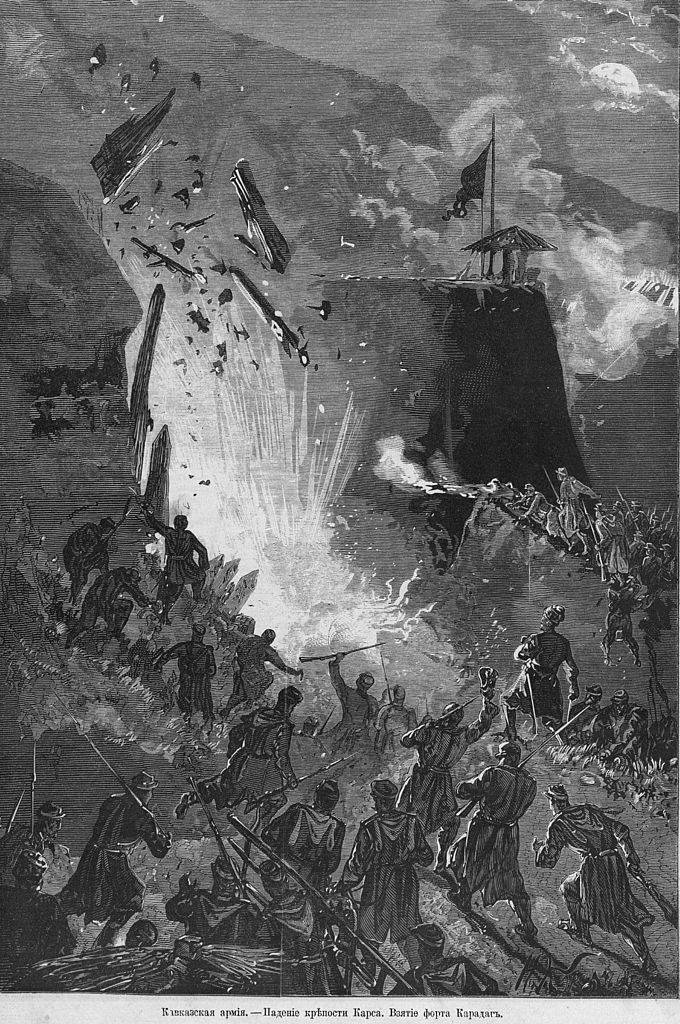
The fall of Kars, 1877, drawing N. N. Karazin
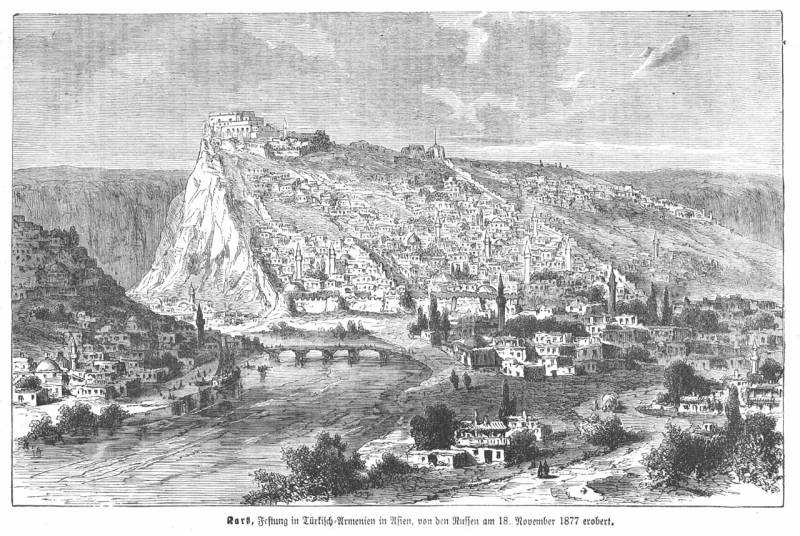
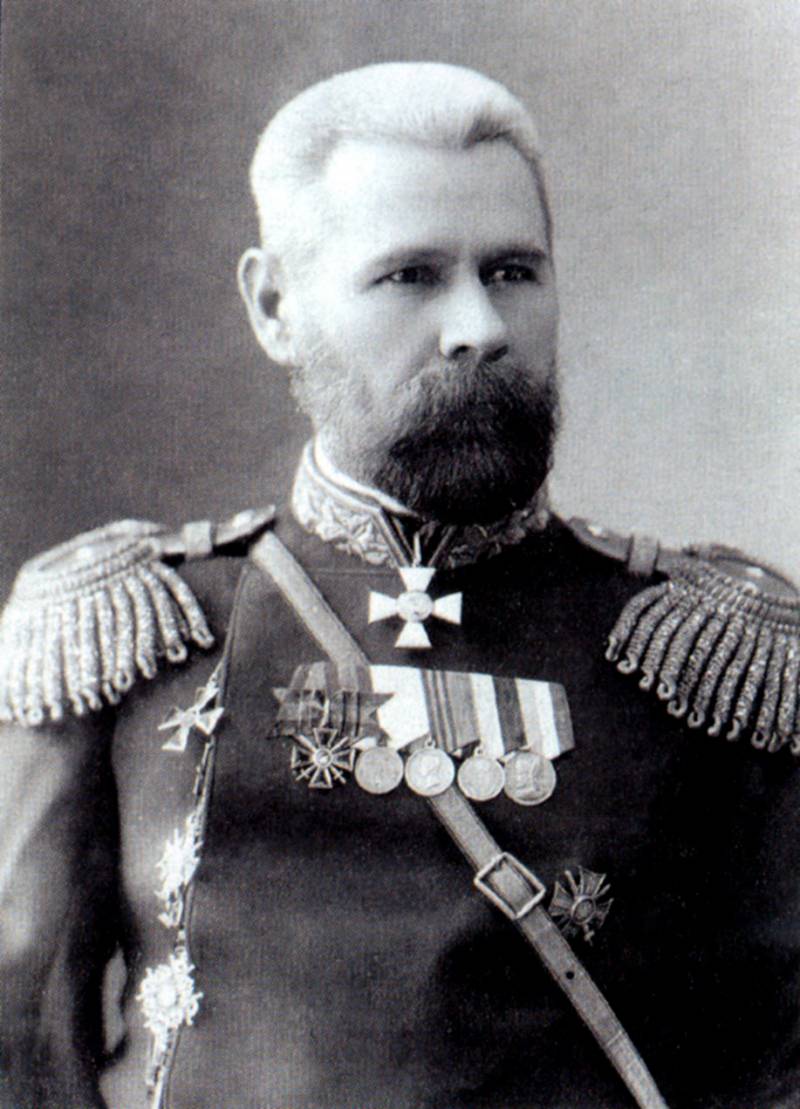
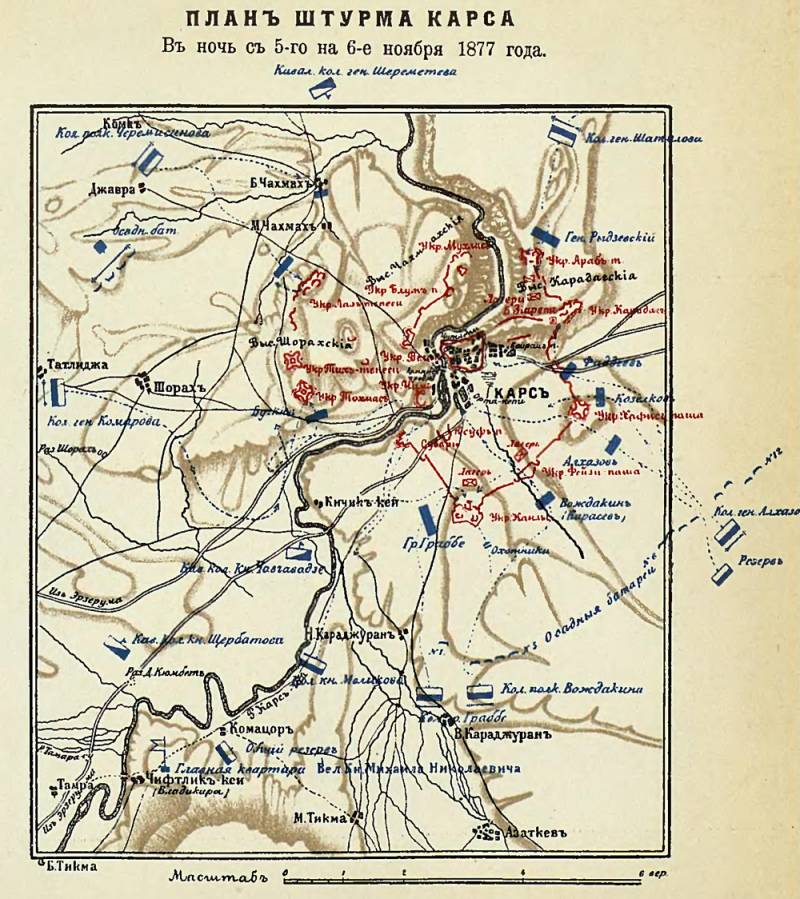
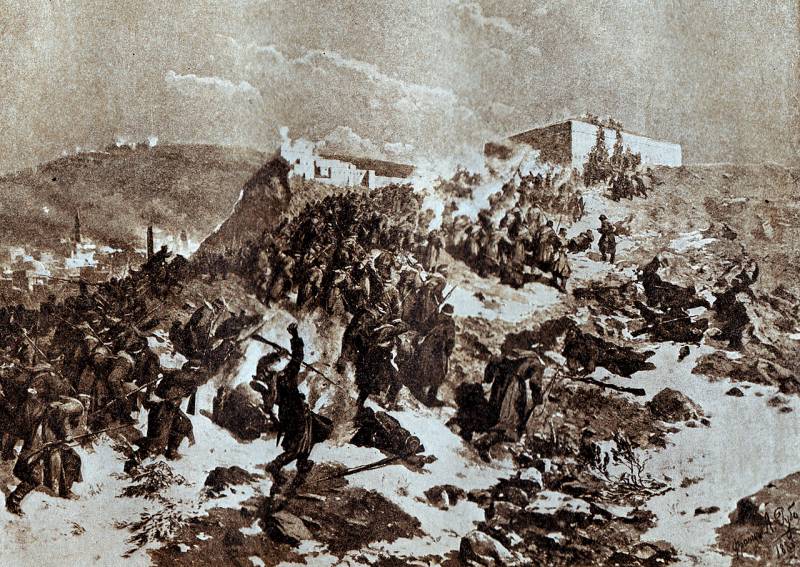
Information